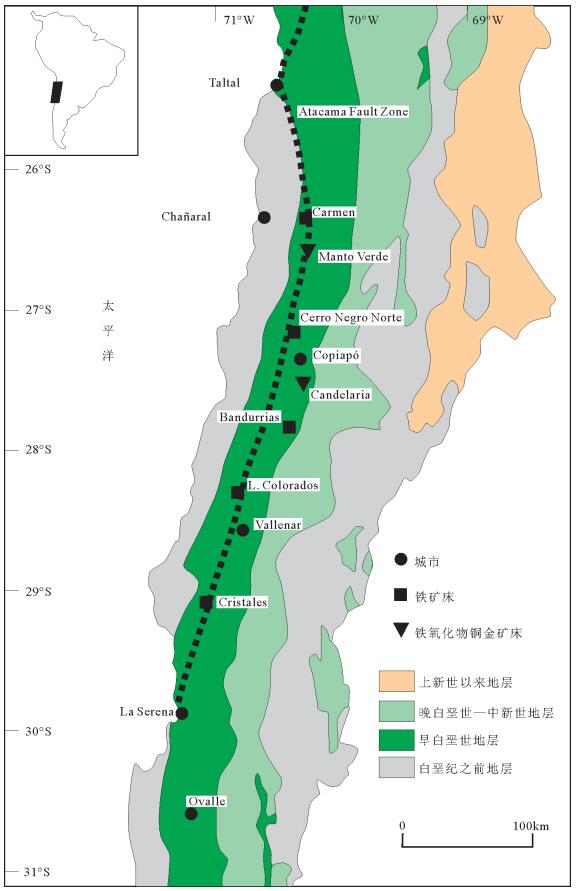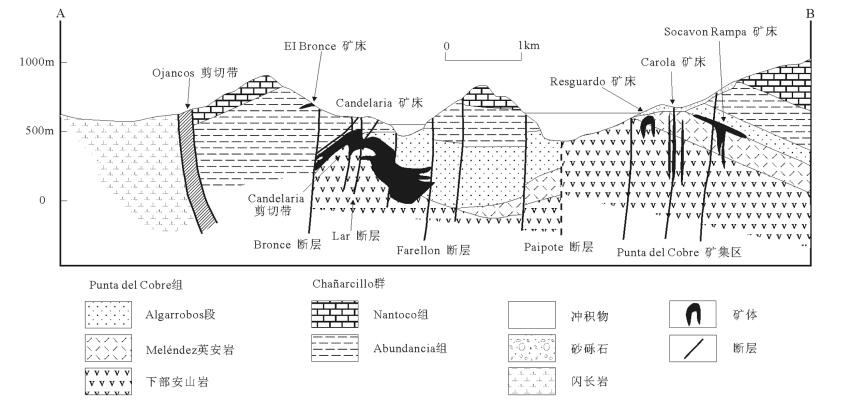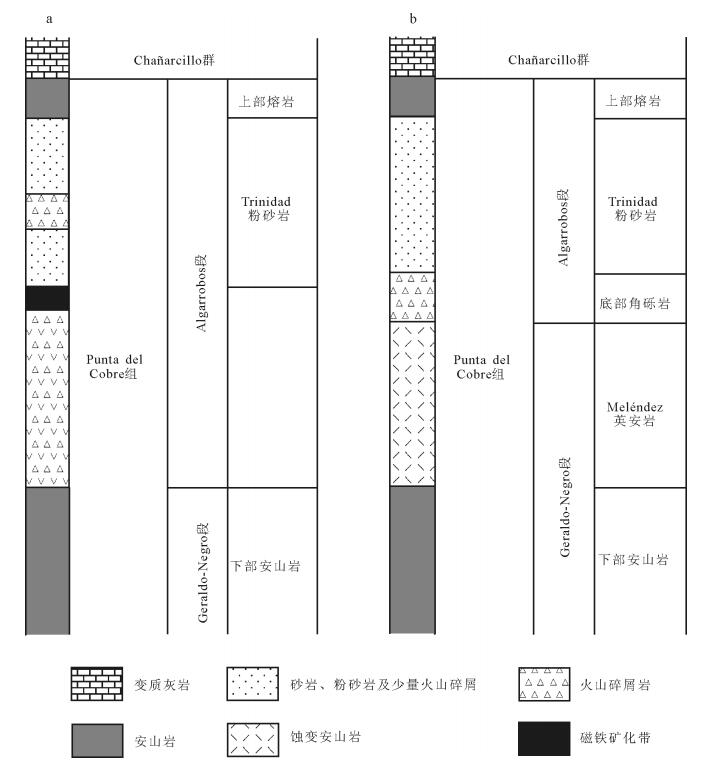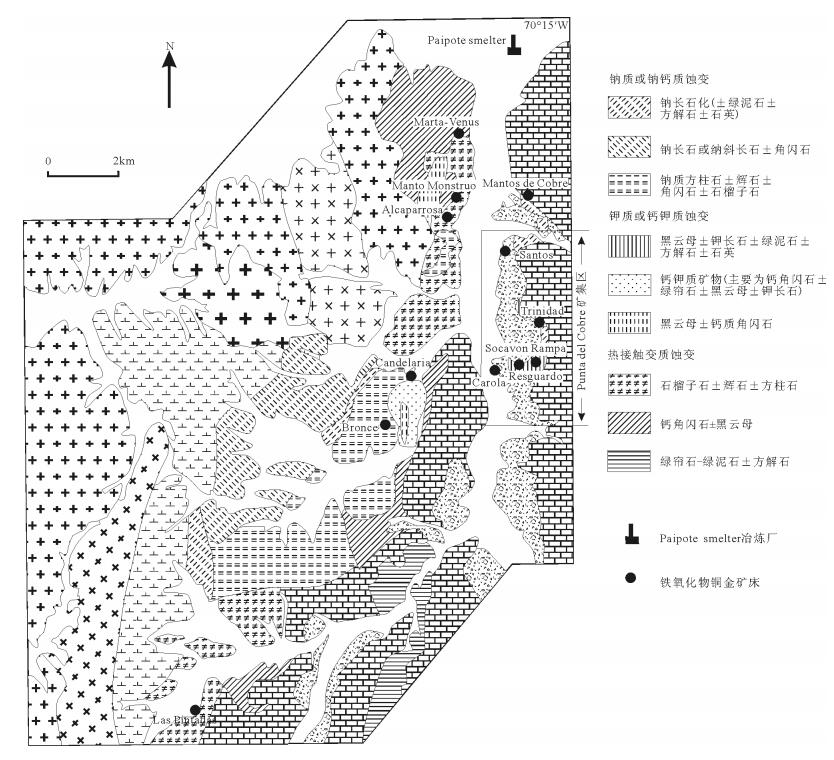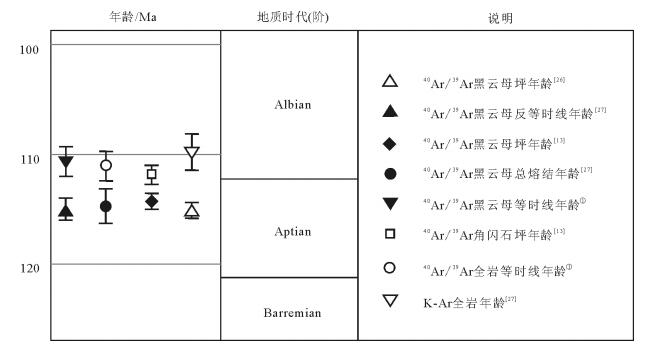Geology and mineralization of the Candelaria-Punta del Cobre Fe oxide Cu-Au deposits, Chile
-
摘要:
智利Copiapó附近海岸东部边缘有一宽5km、长20km的铁氧化物铜金矿床带,包括Candelaria矿床和位于其北东方向3km处的Punta del Cobre矿集区的中小型矿床。初步估计,该成矿带的铜矿石资源量可达7×108~8×108t(含铜量1%)。矿石矿物主要为黄铜矿、黄铁矿、磁铁矿、赤铁矿。矿石产状为脉状、角砾状、细脉状等。含矿围岩主要为Punta del Cobre组的火山岩及火山碎屑岩。该矿带中大部分大型矿脉位于北西-北北西向高角度脆性断层与块状火山岩和火山碎屑岩接触带交汇处。Candelairia矿区主要发育黑云母-钾长石±钙角闪石±绿帘石蚀变矿物组合。在Punta del Cobr矿集区,矿床深部的矿石围岩蚀变情况与Candelairia地区一致,但是浅部的矿石赋存于黑云母-钾长石或钠长石-绿泥石±方解石蚀变带中。
-
关键词:
- 地质 /
- 成矿作用 /
- Candelaria矿床 /
- Punta del Cobre矿集区 /
- 铁氧化物铜金矿床 /
- 智利
Abstract:There is a 5km wide and 20km long belt of Fe oxide Cu-Au deposits along the eastern margin of the coastal batholith near Copiapó, Chile. It includes the Candelaria deposit and a group of middle and small sized deposits in the Punta del Cobre district, which is located about 3km northeast of the Candelaria mine. It is estimated that the amount of copper ore resources in the belt is 700-800 million tons at 1.0 percent Cu. The ore minerals are mainly chalcopyrite, pyrite, magnetite, hematite. The ores occur in veins, breccia and stringer bodies. The orebodies are hosted mainly by volcanic and volcaniclastic rocks of the Punta del Cobre Formation. Most of the larger orebodies in the belt are situated along NW to NNW trending high-angle brittle faults which intersect the contact between massive volcanic and volcaniclastic rocks. The ores occur mainly in zones with biotite-K feldspar±calcic amphibole±epidote alteration at Candelaria. In the Punta del Cobre district, alteration associated with ores in the deeper parts of the deposits is similar to that at Candelaria, whereas at their shallow levels ores occur in biotite-K-feldspar or albite-chlorite±calcite alteration zones.
-
Keywords:
- geology /
- mineralization /
- Candelaria deposit /
- Punta del Cobre district /
- Fe oxide Cu-Au deposit /
- Chile
-
“燕山运动”由著名地质学家翁文灏先生提出[1],一般泛指影响中国东部地区强烈的中生代构造运动。主要分A期地壳变动幕、中间火山幕和B期地壳变动幕[2]。21世纪前,大量学者对燕山运动的幕式运动方式提出不同看法,其中,Hsieh[3]认为可以分为5期;赵宗溥等[4]认为应该回归“燕山运动”提出的本意,专指中侏罗世中晚期造山运动,其主要标志为侏罗系底部大型不整合面(侏罗系髫髻山组火山岩不整合于煤炭系地层之上)。通过对山西地区陆相沉积盆地的深入研究,部分学者认为燕山运动的起始时代为168 Ma[5]。
“燕山运动”构造事件对欧亚大陆产生广泛影响,从欧亚板块东部到板块内部都有“燕山运动”的构造表现。例如,中国东部郯庐断裂持续性活动[6],大巴山地区侏罗纪陆内造山作用[7],中国西北地区北山侏罗纪大规模逆冲推覆构造[8]。综合构造动力学机制,董树文等[9]将燕山运动划分为3个构造期次,早期挤压应力作用期(175~136 Ma),中期伸展应力作用期(135~90 Ma)和晚期弱挤压应力作用期(约80 Ma)。此分类方法全面反映了燕山运动幕式构造过程。早期挤压作用产生大量逆冲推覆构造及相关断层,中期伸展作用产生大量伸展性盆地及变质核杂岩[10-12]。此外,从岩浆响应来说,燕山期岩浆主要可以分为3个活动峰期:160 Ma、140~120 Ma和110~90 Ma[13]。
“燕山运动”无论是从构造上还是从岩浆作用上都有强烈响应。例如,部分地区发育薄皮构造,表现为上地壳基底和盖层内的滑脱构造(大巴山、山西台地和川西),判断依据为大量地震剖面[9];部分地区(苏鲁—大别山和燕山)则表现为厚皮构造特征,指示下地壳受晚侏罗世强烈构造变形影响。与构造作用和岩浆作用不同的是,“燕山运动”期变质作用研究鲜有报道,仅大兴安岭北部与福建东南沿海地区等地区有少量报道[7]。“燕山运动”作为中生代大规模构造运动,尤其在中国东部地区(例如苏鲁造山带)表现为厚皮构造,是否会伴随有相应的变质作用?最近,笔者在胶北地体与北苏鲁超高压造山带接触带开展1:5万变质岩区专题填图的过程中,发现了乳山无极地区出露的含榴斜长角闪岩经历燕山期变质作用。基于此,本次研究对无极地区(石榴)斜长角闪岩不仅开展了详细的野外调查工作,而且开展相应的室内研究,主要包括锆石和榍石U-Pb定年工作。研究结果发现,研究区存在燕山期变质作用,故此探讨其形成原因及构造过程。
1. 地质背景及样品岩石学特征
1.1 地质背景
研究区位于苏鲁超高压变质带内,烟台-青岛-五莲断裂带东南侧(图 1),岩石主要由花岗质片麻岩及大量榴辉岩透镜体,花岗质片麻岩和榴辉岩原岩时代均为新元古代,地球化学特征指示它们与扬子板块北缘的变质基底具有亲缘性,普遍经历中三叠世超高压榴辉岩相变质作用和晚三叠世角闪岩相退变质作用[12, 14-16]。
需要指出的是,烟台-青岛-五莲断裂带东南侧除原岩为新元古代并经历三叠纪超高压变质作用的花岗质片麻岩和榴辉岩透镜体外,许多非超高压变质岩系也陆续被发现。例如,乳山-海阳出露一套典型的非超高压变质岩系,含有经历麻粒岩相变质作用的变基性岩,一般呈块状或构造透镜体形式发育于强变形的花岗质片麻岩中。部分学者认为麻粒岩来自于扬子板块变质基底[17-18]。然而经过深入的研究,越来越多研究者认为这套岩石可能与胶-辽-吉带胶北地体古元古代变质岩具有较好的亲缘性,推测麻粒岩原岩来源于华北克拉通[19-22]。熊志武等[23]通过Hf同位素工作显示,威海地区泥质麻粒岩及石榴黑云片麻岩中εHf(t)范围为-3.7~6.3,二阶段模式年龄为2.78~2.87 Ga,认为这些地壳残片属于华北克拉通。
此外,研究区还出露了一定规模的古元古代变沉积岩(图 2)与少量的中元古代基性侵入岩[24]。研究区发育大量侏罗纪—白垩纪花岗岩[25],其中可见大量元古宙—新元古代变质地层及其他捕虏体。
1.2 样品位置及岩石学特征
本次研究的样品石榴斜长角闪岩19TZH10-1采自午极镇念头村东(图 2、图 3),岩石呈透镜体状产于含榴花岗岩中(图 3)。野外露头呈暗灰色,手标本可见大量斜长石(30%~40%)和角闪石(40%~50%)(图 4-a)。此外,可见暗红色石榴子石(约10%)分布于其他矿物之间。镜下可见自形-他形的石榴子石、斜长石及角闪石交织连晶,呈粒状变晶结构(图 4-b)。局部可见石榴子石边部发育有“白眼圈”结构,与朱浩忠等[24]发表的19LR39-1样品(图 3,西50 m)一致。石榴斜长角闪岩围岩为石榴花岗岩,其时代约为120 Ma。
斜长角闪岩样品19LR44-2采集于午极镇北侧公路边(图 3),与古元古代荆山群黑云斜长片麻岩相伴产出。野外露头呈暗灰色,可见大量白色花岗质浅色脉体(图 4-c)。矿物组成主要为斜长石和角闪石(图 4-d),同时含少量的磁铁矿、锆石和榍石。
2. 实验方法
锆石分选完成于河北省区域地质矿产调查研究所实验室。室内先将所取样品19TZH10-1和19LR44-2破碎至合适粒级,后经清洗、烘干和筛选后,采用磁选和重液分选出约300粒不同粒级的锆石及榍石晶体,后在双目镜下挑选出颗粒较好、裂隙较少且晶形较完整的锆石和榍石晶体进行制靶。锆石阴极发光(CL)图像和榍石背散射电子图像(BSE)均拍摄于南京宏创地质勘查技术服务有限公司,其拍摄实验仪器为TESCAN场发射扫描电镜(型号:MIRA 3LMH),搭配CL探头。实验过程中加速电压为7 kV,吸收电流为1.2 nA,每80 s进行一次扫描。
使用锆石CL图像和榍石背散射电子图像,对2个样品进行年代学分析。其中19TZH10-1样品年龄测定在武汉上谱公司完成,具体方法见Zong等[26]。样品19TZH10-1榍石U-Pb定年和样品19LR44-2锆石U-Pb定年实验在北京快科赛默科技有限公司实验室完成。所用实验仪器为安捷伦串联四级杆电感耦合等离子体质质谱仪(Aglient ICP-MS/MS8900),联机使用的激光器型号是ESI公司生产的准分子激光剥蚀系统New Wave NWR 193UC。其定年方法、仪器条件和数据处理见Ji等[27]。其中,锆石U-Pb定年使用的标样为91500,榍石定年使用的标样为OLT1。
3. 结果
3.1 样品19TZH10-1锆石及榍石年龄特征
样品19TZH10-1为石榴斜长角闪岩,在锆石CL图像中,绝大部分锆石呈板柱状(图 5-a),少量出现裂纹,颗粒均一。值得注意的是,大部分锆石发育极窄的变质增生边(约10 μm),仅少量锆石的变质增生边达到35 μm。
本次研究对样品19TZH10-1中25个锆石微区开展了U-Pb测年,共获得23个有效数据点,分析结果见表 1。其中,23个测点的U含量范围为638.25×10-6 ~ 8868.82×10-6,相应的Th/U值为0.32~1.78。在谐和曲线图解上,23个测点的U-Pb体系谐和度在95%以上,23个测点拟合的不一致线(MSWD=0.56)上交点年龄为1706±16 Ma,因距离下交点较远,未获得精确的下交点年龄。
表 1 乳山地区镇念头石榴斜长角闪岩LA-ICP-MS锆石U-Th-Pb测试结果Table 1. LA-ICP-MS U-Th-Pb dating results of magmatic zircons from the Niantou garnet amphibolite in the Rushan area样品分析点 含量/10-6 Th/U 同位素比值 同位素年龄/Ma 谐和度 Commonpb Totalpb Th U 207pb/206pb lσ 207pb/235U lσ 206Pb/238U lσ 207pb/206pb lσ 207pb/235U lσ 206Pb/238U lσ 19TZH10-1-22 169.53 953.64 747.11 1447.69 0.52 0.1079 0.0022 4.6974 0.1350 0.3126 0.0053 1765 42 1767 24 1754 26 99% 19TZH10-1-10 254.35 2735.40 2913.94 2692.30 1.08 0.1059 0.0019 4.6027 0.0814 0.3137 0.0024 1729 32 1750 15 1759 12 99% 19TZH10-1-13 11.44 1290.18 1388.14 1551.56 0.89 0.1049 0.0018 4.3359 0.0764 0.2982 0.0022 1713 31 1700 15 1682 11 98% 19TZH10-1-02 66.88 11451.63 15810.62 8868.82 1.78 0.1048 0.0017 4.2355 0.0729 0.2912 0.0028 1711 29 1681 14 1648 14 98% 19TZH10-1-24 36.25 1102.31 1196.31 1268.37 0.94 0.1047 0.0019 4.3730 0.0824 0.3017 0.0022 1709 34 1707 16 1700 11 99% 19TZH10-1-11 26.39 928.40 944.74 933.18 1.01 0.1046 0.0019 4.6003 0.0879 0.3180 0.0035 1707 35 1749 16 1780 17 98% 19TZH10-1-19 43.28 1243.21 1328.84 1387.98 0.96 0.1043 0.0022 4.4193 0.0986 0.3059 0.0029 1702 39 1716 19 1720 14 99% 19TZH10-1-20 0.00 1113.48 1256.81 1223.24 1.03 0.1043 0.0022 4.3299 0.0930 0.2998 0.0023 1702 39 1699 18 1690 12 99% 19TZH10-1-1B 2.45 1327.93 1307.31 1621.15 0.81 0.1036 0.0022 4.3926 0.0962 0.3060 0.0027 1700 39 1711 18 1721 14 99% 19TZH10-1-04 45.35 6788.49 9107.51 6518.69 1.40 0.1036 0.0016 4.2505 0.0749 0.2957 0.0032 1700 28 1684 15 1670 16 99% 19TZH10-1-16 59.04 2980.62 3231.33 3700.83 0.87 0.1042 0.0019 3.9718 0.0735 0.2753 0.0021 1700 34 1628 15 1568 11 96% 19TZH10-1-0B 10.55 457.28 431.65 638.25 0.68 0.1041 0.0023 4.3579 0.0933 0.3023 0.0025 1698 41 1704 18 1703 13 99% 19TZH10-1-23 15.98 555.20 576.59 749.90 0.77 0.1040 0.0022 4.2531 0.0943 0.2951 0.0026 1698 39 1684 18 1667 13 98% 19TZH10-1—17 32.11 1344.13 1429.36 1765.74 0.81 0.1040 0.0021 4.1373 0.0840 0.2873 0.0024 1696 36 1662 17 1628 12 97% 19TZH10-1-21 13.92 1987.68 2135.00 2464.27 0.87 0.1038 0.0020 4.2025 0.0834 0.2925 0.0024 1694 36 1675 16 1654 12 98% 19TZH10-1-03 55.03 5306.66 5731.78 5967.90 0.96 0.1035 0.0016 4.2538 0.0653 0.2962 0.0023 1689 28 1684 13 1672 11 99% 19TZH10-1-25 14.77 804.12 877.97 961.23 0.91 0.1033 0.0019 4.2723 0.0795 0.2988 0.0023 1684 33 1688 15 1685 12 99% 19TZH10-1-07 14.86 2541.00 2849.57 2824.83 1.01 0.1031 0.0021 4.2557 0.0878 0.2978 0.0025 1681 38 1685 17 1680 13 99% 19TZH10-1-06 32.76 628.59 640.87 751.30 0.85 0.1024 0.0023 4.3748 0.1000 0.3083 0.0029 1678 42 1708 19 1732 14 98% 19TZH10-1-14 0.00 4828.21 5543.63 5497.82 1.01 0.1029 0.0017 4.1447 0.0733 0.2907 0.0026 1677 31 1663 15 1645 13 98% 19TZH10-1-12 1.60 1150.96 805.18 2221.89 0.36 0.1028 0.0017 4.0833 0.0677 0.2866 0.0019 1676 25 1651 14 1624 9 98% 19TZH10-1-09 24.61 1835.55 1943.51 2087.16 0.93 0.1028 0.0019 4.3688 0.0840 0.3065 0.0024 1676 35 1706 16 1724 12 99% 19TZH10-1-05 41.29 458.87 289.35 898.88 0.32 0.1011 0.0019 4.1547 0.0789 0.2961 0.0025 1656 34 1665 16 1672 12 99% 此外,本次研究还对样品19TZH10-1开展了榍石U-Pb测年,定年结果见表 2。共获得30个有效数据点,其中Th/U值为1.54~4.77,在Tera-Wesserburg图解上,这些数据点构成一条线性良好的不一致线(图 6),下交点年龄为154±10 Ma。需要特别指出的是,朱浩忠等[24]文中可见1颗锆石的变质增生边较宽(图 5左下),并获得相应的206Pb/238U年龄为145 Ma,与上述榍石的下交点年龄在误差范围一致。
表 2 乳山地区念头石榴斜长角闪岩LA-ICP-MS榍石U-Th-Pb测试结果Table 2. U-Th-Pb dating results of titanite from the Niantou garnet amphibolites in the Rushan样品分析点 含量/10-6 Th/U 同位素比值 年龄/Ma pbTotal Th U 207pb/206pb lσ 207pb/235U lσ 206Pb/238U lσ 206Pb/238U lσ 207pb/235U lσ 19TZH10-1#5 243 30.00 19.50 1.54 0.449 0.02 3.76 0.19 0.06 0.0027 375 17 1574 41 19TZH10-1#18 264 43.10 24.20 1.78 0.427 0.016 2.99 0.13 0.0512 0.0021 321 13 1395 35 19TZH10-1#3 271 46.50 25.49 1.82 0.42 0.024 2.74 0.13 0.0493 0.0021 310 13 1355 39 19TZH10-1#10 288 43.40 22.77 1.91 0.446 0.021 3.21 0.15 0.0528 0.0022 332 14 1449 36 19TZH10-1#16 278 44.50 21.41 2.08 0.437 0.036 3.24 0.22 0.0546 0.0027 343 17 1458 54 19TZH10-1#21 282 47.40 22.37 2.12 0.428 0.027 3.15 0.18 0.0541 0.0029 339 18 1439 42 19TZH10-1#13 294 49.80 22.19 2.24 0.468 0.02 3.55 0.15 0.0558 0.002 350 12 1529 33 19TZHl0-l#19 284 51.90 22.51 2.31 0.438 0.023 3.22 0.15 0.0541 0.0025 340 15 1456 37 19TZH10-1#20 384 60.50 24.43 2.48 0.429 0.024 3 0.16 0.0508 0.0021 320 13 1400 40 19TZH10—1#2 273 50.60 19.61 2.58 0.46 0.025 3.7 0.18 0.0589 0.0022 369 13 1565 39 19TZH10-1#22 328 76.00 29.25 2.60 0.39 0.022 2.66 0.22 0.0478 0.0024 301 15 1305 59 19TZH10-1#7 290 62.70 23.80 2.63 0.421 0.019 2.92 0.13 0.0504 0.0018 317 11 1378 35 19TZH10-1#15 351 73.90 27.80 2.66 0.389 0.024 2.54 0.17 0.0462 0.0018 291 11 1274 46 19TZH10-1#17 355 75.30 27.30 2.76 0.409 0.018 2.77 0.13 0.0498 0.0021 313 13 1336 35 19TZH10—1#4 299 52.10 18.82 2.77 0.482 0.024 3.71 0.16 0.0565 0.0024 354 15 1568 33 19TZH10-#23 349 73.80 26.40 2.80 0.433 0.02 3.02 0.16 0.051 0.0025 321 15 1404 42 19TZH10—1#9 304 58.80 20.07 2.93 0.464 0.022 3.65 0.18 0.0571 0.0024 357 14 1550 40 19TZH10-1#14 294 40.90 13.57 3.01 0.553 0.023 6.08 0.26 0.0808 0.0031 500 18 1975 37 19TZH10-1#1 305 61.00 19.57 3.12 0.439 0.017 3.55 0.18 0.0583 0.0022 365 13 1530 40 19TZH10-#24 320 67.60 21.51 3.14 0.452 0.033 3.44 0.22 0.0559 0.0032 350 19 1506 51 19TZH10-1#30 274 60.80 19.27 3.16 0.447 0.02 3.39 0.14 0.0555 0.0017 348 10 1493 32 19TZH10-1#6 392 84.30 26.31 3.20 0.425 0.018 2.86 0.12 0.0498 0.0019 313 12 1372 33 19TZH10—1#28 353 110.10 31.40 3.51 0.363 0.015 2.21 0.1 0.0445 0.0013 280.5 8.3 1177 31 19TZH10-1#12 377 90.30 25.21 3.58 0.408 0.017 2.76 0.13 0.049 0.0018 308 11 1335 36 19TZH10-#27 347 96.20 26.80 3.59 0.411 0.019 2.68 0.12 0.0475 0.0015 299 9.3 1316 33 19TZH10-#25 366 117.60 31.20 3.77 0.369 0.014 2.29 0.1 0.0452 0.0017 285 11 1201 30 19TZH10—1#29 357 105.00 27.27 3.85 0.401 0.018 2.57 0.1 0.047 0.0015 295.8 9 1290 27 19TZH10-1#11 387 89.40 22.35 4.00 0.44 0.02 3.1 0.13 0.0514 0.0021 323 13 1425 32 19TZH10—1#8 292 72.30 16.50 4.38 0.487 0.028 4.03 0.22 0.0607 0.003 379 18 1632 44 19TZH10-#26 403 109.40 22.94 4.77 0.449 0.025 3.22 0.19 0.0525 0.0023 330 14 1453 46 3.2 样品19LR44-2锆石年龄特征
样品19LR44-2(斜长角闪岩)中锆石主要为浑圆状与不规则状,在锆石阴极发光(CL)图像上,可进一步将其分为3类(图 7):第一类锆石具有较强的阴极发光效应(亮白色),可隐约观察到振荡环带;第二类锆石具有中等阴极发光效应(灰色),振荡环带不明显;第三类锆石发暗发黑,振荡环带不明显。此外,有的锆石发现典型的核-边结构(图 6)。
对该样品上述3类锆石进行U-Pb测年(表 3),可进一步划分为2组年龄。33个古元古代锆石测点的U含量为23.90×10-6~1825×10-6,相应的Th/U值为0.10~0.63,平均值为0.36,这些数据点构成一条线性良好的不一致线,上交点年龄为1835±12 Ma,由于测点离下交点较远,得到不精确的下交点年龄为216±79 Ma。此外,2个燕山期变质锆石测点U含量分别为2290×10-6与1805×10-6,相应的Th/U值分别为0.07与0.09,206Pb/238U年龄分别为144±1.5 Ma和135±2.5 Ma。
表 3 乳山地区北庄斜长角闪岩LA-ICP-MS锆石U-Th-Pb定年结果Table 3. LA-ICP-MS U-Th-Pb dating results of zircons from the Beizhuang amphibolites in the Rushan样品分析点 含量/10-6 Th/U 同位素比值 年龄/Ma 谐和度 Totalpb Th U 207pb/235U 2σ 206Pb/238U 2σ 207pb/206pb 2σ 207pb/235U 2σ 206Pb/238U 2σ 19LR44-2#33 78.9 127.5 1232 0.10 3.355 0.031 0.227 0.0022 1751 11 1493 7.1 1317 12 113.37 19LR44-2#30 26.7 42.7 355 0.12 3.993 0.049 0.261 0.0028 1805 16 1633 10 1494 14 109.3 19LR44—2#22 110.4 180.6 1168 0.15 3.64 0.035 0.239 0.0023 1802 10 1557 7.8 1380 12 112.86 19LR44-2#32 123.2 170.3 999 0.17 4.413 0.038 0.29 0.0027 1793 9.7 1714 7.2 1643 14 104.31 19LR44-2#1 251.2 309 1733 0.18 4.467 0.049 0.29 0.0036 1818 9.8 1724 9.3 1643 18 104.95 19LR44-2#7 100.1 133.8 755 0.18 4.254 0.043 0.279 0.0029 1802 12 1683 8.3 1587 14 106.07 19LR44-2#3 165.8 229 1224 0.19 3.38 0.047 0.225 0.0032 1772 13 1498 11 1308 17 114.53 19LR44—2#6 144.1 183 947 0.19 4.213 0.044 0.272 0.0027 1832 11 1675 8.6 1548 14 108.21 19LR44—2#20 63.3 113.1 593 0.19 2.795 0.054 0.191 0.0033 1726 20 1354 14 1127 18 120.14 19LR44-2#39 112.5 135.3 731 0.19 4.266 0.057 0.271 0.0037 1857 12 1685 11 1545 19 109.06 19LR44—2#8 121.8 159.4 720 0.22 4.555 0.046 0.295 0.0029 1827 10 1740 8.3 1664 15 104.56 19LR44-2#12 143.9 191.5 843 0.23 4.506 0.05 0.29 0.0028 1834 11 1732 9.4 1643 14 105.42 19LR44-2#15 47.9 59.4 248 0.24 5.268 0.056 0.332 0.003 1870 14 1862 8.9 1848 15 100.77 19LR44-2#16 34.4 48.6 204 0.24 4.816 0.059 0.307 0.0033 1851 17 1786 10 1726 16 103.48 19LR44—2#2 297.6 463.1 1805 0.26 3.385 0.031 0.226 0.0021 1766 9.1 1501 7.2 1315 11 114.14 19LR44-2#35 23.9 30.2 108 0.28 4.779 0.082 0.308 0.004 1831 25 1781 15 1731 20 102.89 19LR44—2#4 430 488.5 1675 0.29 4.778 0.052 0.31 0.0033 1817 10 1780 9.1 1742 16 102.16 19LR44—2#24 39.3 51.2 180 0.29 4.597 0.067 0.302 0.0038 1801 18 1748 12 1698 19 102.94 19LR44—2#26 72 104 314 0.33 4.387 0.053 0.284 0.003 1826 15 1708 9.9 1609 15 106.16 19LR44—2#23 49.1 63.9 177 0.36 4.722 0.06 0.305 0.0034 1825 17 1769 11 1715 17 103.15 19LR44—2#28 62.1 74.6 199 0.37 4.897 0.08 0.317 0.005 1826 17 1800 14 1772 25 101.58 19LR44—2#10 104.8 137 353 0.39 4.496 0.061 0.292 0.0037 1816 15 1728 11 1648 18 104.85 19LR44-2#19 162.2 215.3 511 0.42 4.798 0.054 0.309 0.0034 1840 12 1784 9.7 1733 17 102.95 19LR44-2#31 54.6 78 176 0.44 4.419 0.067 0.286 0.0041 1822 20 1713 13 1621 21 105.68 19LR44-2#21 99.8 128.5 276 0.47 4.721 0.05 0.31 0.0029 1805 14 1772 9 1737 14 101.99 19LR44—2#9 181.3 253.7 534 0.48 4.366 0.048 0.282 0.0032 1828 11 1704 9.1 1602 16 106.38 19LR44-2#10 21.9 30.39 63.7 0.48 4.436 0.072 0.29 0.004 1799 29 1716 13 1641 20 104.57 19LR44-2#14 13.7 18.38 38.4 0.48 4.51 0.11 0.294 0.005 1811 40 1725 20 1659 25 103.98 19LR44—2#29 650 903 1825 0.49 4.319 0.045 0.285 0.003 1791 9.5 1696 8.7 1616 15 104.93 19LR44-2#34 27.2 34.9 62.6 0.56 4.694 0.091 0.311 0.0046 1780 29 1763 16 1744 23 101.09 19LR44—2#25 11.B 14.23 23.9 0.60 5.26 0.15 0.339 0.0073 1815 48 1851 24 1879 35 98.51 19LR44-2#17 16.8 22.3 35.5 0.63 4.85 0.11 0.314 0.0057 1818 38 1786 19 1760 28 101.48 19LR44-2#38 29.8 46.1 72.9 0.63 3.758 0.093 0.248 0.0055 1795 41 1582 21 1427 28 110.86 19LR44-2#13 9.24 156.2 2290 0.07 0.144 0.003 0.021 0.0004 165 32 137 2.9 135 2.6 101.71 19LR44-2#18 10.33 170.9 1805 0.09 0.153 0.002 0.023 0.0002 158 31 145 2 144 1.5 100.91 4. 讨论
4.1 燕山期变质作用的成因
对于乳山地区斜长角闪岩及含榴斜长角闪岩燕山期变质作用成因,本文提出2种不同的认识加以讨论:①变质作用与构造作用相关,它们是侏罗纪挤压造山作用过程中区域变质-变形作用的产物。②变质作用与构造作用无关,其成因与侏罗纪岩浆作用热接触变质相关。首先,从构造角度来说,胶东半岛下地壳在侏罗纪受厚皮构造控制,大量逆冲断层出现,致使各类岩石发生大规模重复性叠置形成双冲构造[28-29]。早期强烈挤压期构造发生于175~136 Ma[9],与文中所得变质时代在时间上具有重叠期,故此构造作用引起的区域性变质作用需要加以考虑。其次,朱浩忠等[24]经过对19LR39-1进行详细的岩石学及相平衡模拟后,发现2期变质作用存在于含榴斜长角闪岩中,第一期含“白眼圈”退变质反应结构的变质事件可能发生在三叠纪。然而,对于第二期含“红眼圈”结构的变质反应,文中并未进行深入讨论,本次研究根据锆石变质边部及榍石年代学特征,推测其可能产生于“燕山运动”时期。
对于燕山期变质作用,需要考虑岩浆热接触变质的主要因素为:①到目前为止发现的约145 Ma变质作用都较局部,本次研究得到的变质年龄非常少,含榴斜长角闪岩(19LR39-1)中仅1颗锆石,含榴斜长角闪岩(19LR44-2)中仅发现2颗锆石;②如果是区域性变质作用,胶东半岛地区古元古代沉积岩或岩浆岩中都应该有记录,尤其是研究区荆山群内的泥质片岩,更应该记录燕山期变质事件,然而前人对此变质事件报道非常少,早期变质作用相关报道主要集中于三叠纪变质事件。
胶东半岛中生代主要发育2期岩浆作用(160 Ma和120 Ma)[9],早期岩浆作用可能与挤压背景相关,晚期岩浆作用与伸展背景相关,二者之间也有少量岩浆活动。然而需要指出的是,本次研究所得约143 Ma变质锆石的石榴斜长角闪岩,其围岩为120 Ma石榴二长花岗岩[24],斜长角闪岩19LR44-2的围岩伟晶岩形成时代也为120 Ma左右,并非140 Ma左右的岩浆岩。石榴斜长角闪岩是先发生变质作用,后被120 Ma围岩捕获带至地壳浅层位置。故此,围岩岩浆热接触变质作用的观点还需要进一步斟酌。
4.2 燕山期变质作用时代与区域构造事件联系
董树文等[9]对燕山地区的逆冲推覆构造及地层不整合事件进行了全面综述,认为挤压构造初始时间为175~160 Ma,持续时间为30~35 Ma,此后由于大规模火山岩出现,于约135 Ma转换为受伸展环境控制的构造活动。该认识与Wang等[30]一致,认为大青山地区陆内挤压变形发生在170 Ma左右,其主要依据为变形过程中生长地层的发育时代。大巴山地区挤压性构造发育时间被限定为178~143 Ma[31-32]。经过系统总结与研究,董树文等[9]最终将“燕山运动”分为挤压期、主伸展期和弱挤压期,其时代分别为175~136 Ma、135~90 Ma和80 Ma(图 8)。燕山期岩浆作用发育,主要集中在3个峰期:约160 Ma、140~120 Ma和110~90 Ma[13](图 8),其中胶东地区(本文研究区)岩浆作用主要集中在160 Ma和120 Ma[25]。
前人对中国东部燕山期变质作用变质岩的研究较少,仅董树文等[7]对大兴安岭北部出露的一套变质岩沉积岩系进行了总结分析,并总结U-Pb锆石测年结果,获得其变质年龄为159~163 Ma。本文获得:①石榴斜长角闪岩原岩年龄为1734 Ma,并经历中生代变质作用(榍石年龄为154±10 Ma)。榍石封闭温度比锆石低,本次研究中榍石年龄特征能够指示变质作用发生。②通过锆石变质增生边可知,石榴斜长角闪岩变质时代约为145 Ma。③斜长角闪岩第一期变质时代为1850±12 Ma,第二期变质时代为145~135 Ma。由此可知,受“燕山运动”控制的变质时代为145~135 Ma。需要指出的是,在经历强烈挤压变形期之后,研究区进入区域性快速伸展期,主要依据为大量白垩纪(135~120 Ma)变质核杂岩的形成[10-12]。故此,笔者认为中生代变质作用发生于挤压背景转换为伸展背景的构造体制下(图 8)。
4.3 燕山期变质作用识别的意义
大规模不同地壳尺度逆冲推覆构造能够指示侧向增生/造山作用,以巨量增生楔/造山楔及岩石相互叠置使地壳加厚;岩浆作用则指示垂向增生,大量岩浆岩侵入同样会导致地壳加厚,二者共同作用,最终构成完整的造山过程(图 9)。对胶东半岛各岩石单元来说,早期175~136 Ma强烈挤压构造和160 Ma岩浆作用共同奠定了侏罗纪晚期—白垩纪早期强烈的造山作用(图 9)。前文已述,变质作用的产生应该以构造因素为主导,岩浆作用影响也不容忽视。遗憾的是,胶东半岛受构造控制及岩浆局部影响的变质作用,并没有像其他增生造山带(安第斯造山带)那样发育。在大规模区域变质作用即将发生时(< 145 Ma),由于古太平洋板块的俯冲角度过高,板片发生大规模后撤作用,致使欧亚板块东部地区发生大规模岩石圈拆沉,全区突然进入白垩纪伸展期[33-34]。大规模伸展作用及伴随的伸展构造(变质核杂岩)使地壳快速减薄,从而阻碍了区域变质作用的发展。
值得指出的是,尽管中国东部在中生代造山阶段进入快速伸展期,还是有少量燕山期变质作用被报道,这对区域地质及造山作用过程的研究至关重要。随着研究的不断深入,越来越多的燕山期变质作用将被发现。故此,本次研究在胶东半岛发现燕山期变质作用的岩石,有力地说明中国东部燕山期造山作用过程不仅包括相关的岩浆作用和构造变形,可能还发育相关的变质作用,三者共同支撑了完整的中国东部燕山期造山过程。即使造山带遭受了晚期构造作用的强烈破坏,其变质记录也应该有所保留,“燕山运动”亦如此。
5. 结论
(1) 通过(含榴)斜长角闪岩锆石及榍石U-Pb定年,得出其经历中生代燕山期变质作用,时代约为154~145 Ma。
(2) 燕山期变质作用成因可能更大程度上与区域造山作用(构造作用)相关,但也不能忽略岩浆作用对该期变质作用的影响。
(3) 燕山期变质作用发生在构造转换期(挤压到伸展),是导致变质事件记录较少的主要原因。
致谢: 论文完成过程中得到中国地质调查局南京地质调查中心芮行健研究员、中国地质科学院矿产资源研究所宋学信研究员的指导,在此致以衷心感谢。 -
表 1 Candelaria -Punta del Cobre成矿带中矿床简介
Table 1 The description of mineral deposits along the Candelaria-Punta del Cobre belt
矿床名称 矿石矿物组合 蚀变矿物 矿石储量和品位 Alcaparrosa mt, cpy, py kspar, bio, act, qtz 10Mt 1.4% Cu Bronce mt, cpy, py scap, gt Candelaria mt, cpy, py bio, kspar, act, qtz 470Mt 0.95% Cu, 0.22g/t Au, 3.1g/t Ag Carola mt, hm, cpy, py kspar, bio, chl, cte 20Mt 1.4% Cu Las Pintadas mt, cpy, py gt, act, kspar 4.0Mt 1.0%~1.5% Cu Manto Monstruo mt, cpy, py calc-silicate Mantos de Cobre mt, cpy, py kspar/ab-chl 1.5Mt 1.45% Cu Resguardo cpy, py, hm, mt ab, chl, cte 6Mt 1.8%~2.0% Cu, 0.4~0.5g/t Au, 7.0g/t Ag Santos mt, cpy, py, hm kspar, bio, chl 20Mt 1.5% Cu, 0.4~0.5g/t Au, 7.0g/t Ag Socavon Rampa cpy, hm, py ab, chl, cte 25Mt 1.2%~2% Cu, 0.2~0.3g/t Au, 7.0g/t Ag Trinidad mt, hm, cpy, py kspar, bio, chl 15Mt 1.5% Cu, 0.2~0.3g/t Au, 7.0g/t Ag Marta -Venus mt, cpy, py, hm gt, act 注:ab—钠长石;act—阳起石;bio—黑云母;chl—绿泥石;cpy—黄铜矿;cte—方解石;gt—石榴石;hm—赤铁矿;kspar—钾长石;mt—磁铁矿;po—磁黄铁矿;py—黄铁矿;qtz—石英;scap—方柱石;sl—闪锌矿;calc-silicate—钙硅酸盐 -
Marschik R, Leveille R A, Martin W.La Candelaria and the Punta del Cobre district, Chile:Early Cretaceous iron oxide cu-au (-ZnAg) mineralization[J].Hydrothermal iron oxide copper-gold and related deposits, 2000, 1:163-175. https://www.researchgate.net/publication/312470464_La_Candelaria_and_the_Punta_del_Cobre_district_Chile_early_Cretaceous_iron-oxide_Cu-_Au-Zn-Ag_mineralization?ev=auth_pub
Segerstrom K, Ruiz C.Geología del Cuadrángulo Copiapó, Provincia de Atacama[J].Carta Geológica de Chile, 1962, 3(1):115
Hitzman M W, Oreskes N, Einaudi M T.Geological characteristics and tectonic setting of proterozoic iron oxide (Cu-U-Au-REE) deposits[J].Precambrian Research, 1992, 58(1/4):241-287. http://www.sciencedirect.com/science/article/pii/0301926892901214
Gow P A, Wall V J, Oliver N H S, et al.Proterozoic iron oxide (Cu-U-Au-REE) deposits:Further evidence of hydrothermal origins[J].Geology, 1994, 22(7):633-636. doi: 10.1130/0091-7613(1994)022<0633:PIOCUA>2.3.CO;2
Rotherham J F, Blake K L, Cartwright I, et al.Stable isotope evidence for the origin of the Mesoproterozoic Starra Au-Cu deposit, Cloncurry district, northwest Queensland[J].Economic Geology, 1998, 93(8):1435-1449. doi: 10.2113/gsecongeo.93.8.1435
Williams P J.Metalliferous economic geology of the Mt Isa eastern succession, Queensland[J].Australian Journal of Earth Sciences, 1998, 45(3):329-341. doi: 10.1080/08120099808728395
Williams P J, Dong G, Pollard P J, et al.Fluid inclusion geochemistry of Cloncurry (Fe)-Cu-Au deposits[J].Mineral deposits:Processes to processing:Rotterdam, Balkema, 1999, 1:111-114. https://www.researchgate.net/publication/262151869_Fluid_inclusion_geochemistry_of_Cloncurry_Fe-Cu-Au_deposits
Battles D A, Barton M D.Arc-related sodic hydrothermal alteration in the western United States[J].Geology, 1995, 23(10):913-916. doi: 10.1130/0091-7613(1995)023<0913:ARSHAI>2.3.CO;2
Haynes D W, Cross K C, Bills R T, et al.Olympic Dam ore genesis:a fluid-mixing model[J].Economic Geology, 1995, 90(2):281-307. doi: 10.2113/gsecongeo.90.2.281
Barton M D, Johnson D A.Evaporitic-source model for igneousrelated Fe oxide-(REE-Cu-Au-U) mineralization[J].Geology, 1996, 24(3):259-262. doi: 10.1130/0091-7613(1996)024<0259:ESMFIR>2.3.CO;2
Hopf S.The Agustina mine, a volcanic-hosted copper deposit in northern Chile[C]//Stratabound Ore Deposits in the Andes.Springer Berlin Heidelberg, 1990:421-434. doi: 10.1007/978-3-642-88282-1_32
Marschik R, Fontboté L.Copper (-iron) mineralization and superposition of alteration events at the Punta del Cobre belt, northern Chile[J].Special Publication of the Society of Economic Geologists, 1996, 5:171-189. https://www.researchgate.net/publication/284698183_Copper-iron_mineralization_and_superposition_of_alteration_events_in_the_Punta_del_Cobre_belt_northern_Chile?ev=auth_pub
Ullrich T D, Clark A H.The Candelaria copper-gold deposit, Region Ⅲ, Chile:Paragenesis, geochronology and fluid composition[C]//Mineral deposits:Processes to processing:Rotterdam, Balkema, 1999:201-204. https://www.researchgate.net/publication/309456889_The_Candelaria_copper-gold_deposit_Region_III_Chile_Paragenesis_geochronology_and_fluid_composition
Mathur R, Marschik R, Ruiz J, et al.Age of mineralization of the Candelaria Fe oxide Cu-Au deposit and the origin of the Chilean iron belt, based on Re-Os isotopes[J].Economic Geology, 2002, 97(1):59-71. doi: 10.2113/gsecongeo.97.1.59
Scheuber E, Hammerschmidt K, Friedrichsen H.40 Ar/39 Ar and Rb-Sr analyses from ductile shear zones from the Atacama Fault Zone, northern Chile:the age of deformation[J].Tectonophysics, 1995, 250(1):61-87. http://www.sciencedirect.com/science/article/pii/0040195195000448
Dallmeyer R D, Brown M, Grocott J, et al.Mesozoic Magmatic and Tectonic Events within the Andean Plate Boundary Zone, 26°-27°30'S, North Chile:Constraints from Mineral Ages[J].The Journal of Geology, 1996, 104(1):19-40. doi: 10.1086/629799
Menard J J.Relationship between altered pyroxene diorite and the magnetite mineralization in the Chilean Iron Belt, with emphasis on the El Algarrobo iron deposits (Atacama region, Chile)[J].Mineralium Deposita, 1995, 30(3):268-274. doi: 10.1007/BF00196362
Tilling R.El Batolito Andino cerca de Copiapó, Provincía de Atacama.Geologíay Petrología[J].Revista Geológica de Chile, 1976, 3:1-24. http://bosques.ciren.cl/handle/123456789/23791
Marschik R, Fontboté L.The Punta del Cobre Formation, Punta del Cobre-Candelaria area, northern Chile[J].Journal of South American Earth Sciences, 2001, 14(4):401-433. doi: 10.1016/S0895-9811(01)00036-0
Arévalo C, Grocott J, Martin W, et al.Structural Setting of the Candelaria Fe Oxide Cu-Au Deposit, Chilean Andes (27°30'S)[J].Economic Geology, 2006, 101(4):819-841. doi: 10.2113/gsecongeo.101.4.819
Arévalo C, Grocott J.The tectonic setting of the Chañarcillo Group and the Bandurrias Formation:An Early-Late Cretaceous sinistral transpressive belt between the Coastal Cordillera and the Precordillera, Atacama region, Chile[J]:Congreso Geológico Chileno, 8th, Antofagasta, 1997, 3:1604-1607.
方维萱, 李建旭.智利铁氧化物铜金型矿床成矿规律、控制因素与成矿演化[J].地球科学进展, 2014, 29(9):1011-1024. doi: 10.11867/j.issn.1001-8166.2014.09.1011 李建旭, 方维萱, 刘家军.智利铁氧化物-铜-金矿床区域定位构造-矿田构造类型与特征[J].地质与勘探, 2011, 47(2):323-332. http://d.wanfangdata.com.cn/Periodical/dzykt201102025 Ryan P J, Lawrence A L, Jenkins R A, et al.The Candelaria copper-gold deposit, Chile[J].Arizona Geological Society Digest, 1995, 20:625-645. https://www.researchgate.net/publication/284671519_The_Candelaria_copper-gold_deposit_Chile
Sillitoe R H, Clark A H.Copper and copper iron sulphides as the initial products of supergene oxidation, Copiapó mining district, northern Chile[J].American Mineralogist, 1969, 54(11-1):1684-1710. http://www.researchgate.net/publication/285630985_Copper_and_copper-iron_sulfides_as_the_initial_products_of_supergene_oxidation_Copiao_Mining_district_Northern_Chile
Marschik R, Fontboté L.The Candelaria-Punta del Cobre iron oxide Cu-Au(-Zn-Ag) deposits, Chile[J].Economic Geology, 2001, 96(8):1799-1826. http://www.researchgate.net/publication/247864095_The_Candelaria-Punta_del_Cobre_Iron_Oxide_Cu-Au(-Zn-Ag)_Deposits_Chile
Marschik R, Singer B S, Munizaga F, et al.Age of Cu (-Fe)-Au mineralization and thermal evolution of the Punta del Cobre district, Chile[J].Mineralium Deposita, 1997, 32(6):531-546. doi: 10.1007/s001260050120
Taylor G K, Grocott J, Pope A, et al.Mesozoic fault systems, deformation and fault block rotation in the Andean forearc:a crustal scale strike-slip duplex in the Coastal Cordillera of northern Chile[J].Tectonophysics, 1998, 299(1):93-109. http://www.sciencedirect.com/science/article/pii/S0040195198002005
Mpodozis C, Allmendinger R W.Extensional tectonics, Cretaceous Andes, northern Chile (27°S)[J].Geological Society of America Bulletin, 1993, 105(11):1462-1477. doi: 10.1130/0016-7606(1993)105<1462:ETCANC>2.3.CO;2
Perez E, Cooper M R, Covacevich V.Aptian ammonite-based age for the Pabellón Formation, Atacama Region, northern Chile[J].Andean Geology, 1990, 17(2):181-185. https://www.researchgate.net/publication/284565651_Aptian_ammonite-based_age_for_the_Pabellon_Formation_Atacama_Region_northern_Chile
Vila T.Geology of the Manto Verde copper deposit, northern Chile:a speculariterich, hydrothermal-tectonic breccia related to the Atacama fault zone[C]//Andean Copper Deposits:New Discoveries, Mineralization Styles and Metallogeny.Soc.Econ.Geol.Spec.Publ.1996, 5:157-169.
Orrego M, Zamora R.Manto Ruso:Un yacimiento de cobre ligado a la Falla de Atacama, Norte de Chile[J].Actas 6th Congr.Geol.Chileno.1991, 1:174-178.
Hopper D, Correa A.The Panulcillo and Teresa de Colmo copper deposits:Two contrasting examples of Fe-ox Cu-Au mineralization from the coastal Cordillera of Chile[C]//Porter T M.Hydrothermal iron oxide copper-gold and related deposits:A global perspective.Australian Mineral Foundation, Adelaide, 2000:177-189.
Cesar E, Vidal C, Injoque-Espinoza J, et al.Amphibolitic Cu-Fe skarn deposits in the central coast of Peru[J].Economic Geology, 1990, 85(7):1447-1461. doi: 10.2113/gsecongeo.85.7.1447
Vivallo W, Espinoza S, Henriquez F.Metasomatismo y alteración hidrotermal en el distrito ferrífero Cerro Negro Norte, Copiapó, Chile[J].Andean Geology, 1995, 22(1):75-88. http://www.researchgate.net/publication/273139884_Metasomatismo_y_alteracion_hidrotermal_en_el_Distrito_Ferrifero_Cerro_Negro_Norte_Copiapo_Chile
Arévalo C. The Coastal Cordillera-Precordillera boundary in the Copiapó area, northern Chile and the structural setting of the Candelaria Cu-Au ore deposit. Kingston University, 1999. Arévalo C. Mapa Geológico de la Hoja Copiapó, Región de Atacama: Santiago,Chile, SERNAGEOMIN, Documentos de Trabajo 8, scale 1∶ 100000, 1995.
Rotherham J F. Origin and Fluid Chemistry of the Starra Ironstones and High Grade Au- cu Mineralisation, Cloncurry District, Mount Isa Inlier, Australia. James Cook University of North Queensland, 1997.
Haller A. The Raul-Condestable iron oxides-Cu-Au deposit, Lima department, Peru: preliminary results. Abstract volume & Field trip guidebook, 2000.




 下载:
下载:








